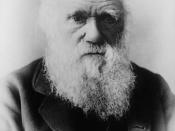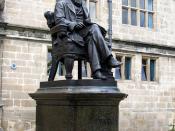The theory of evolution, as set forth by Charles Darwin in 1859, stated that all plant and animal life evolved
over long periods of time from simple to more complicated forms through mutation and adaptation. He
also taught that only the fittest of each species would survive. He further postulated that the first living cell
evolved in a "warm warm little pond" and that it took billions of years for the present diversity of living
things to evolve. At the time, it was thought that the few "missing links" in the fossil record would be soon
filled.(Darwin, 1927 ). Today, however, there is today a considerable body of scientific evidence that
refutes this entire theory. The findings of the last 50 years both deny the possibility of Darwin's
theory and make a very good case for creationism. Creationism is the belief that all of life came into being
suddenly, that it still exists in much the same form, and that the earth is much younger than Darwin
thought. The Law of Biogen!
esis states that life only comes from life. The Harvard University Nobel Prize winner (in physiology and
medicine) George Wald wrote(1954) that "the reasonable view was to believe in spontaneous generation,"
(evolution). He said "the only alternative is to believe in a single, primary act of supernatural creation,"
and "there is no third position." He explains the impossible odds of spontaneous generation, and yet
refuses to accept the alternative. Later, he attempted to find whether a single amino acid change in a
hemoglobin mutation could be found that doesn't adversely affect the function of that hemoglobin. He was
unable to find such an instance. He also explored the interactions between proteins, amino acids, and
oxygen, with energy sources such as the earth's heat and the sun's radiation. He...



Theory of Evolution
You have obviously carried out a good deal of research for this essay. It would be interesting to see the bibliography.
Whereas I am not in complete agreement with all you say, this is cogent and well written work.
6 out of 6 people found this comment useful.